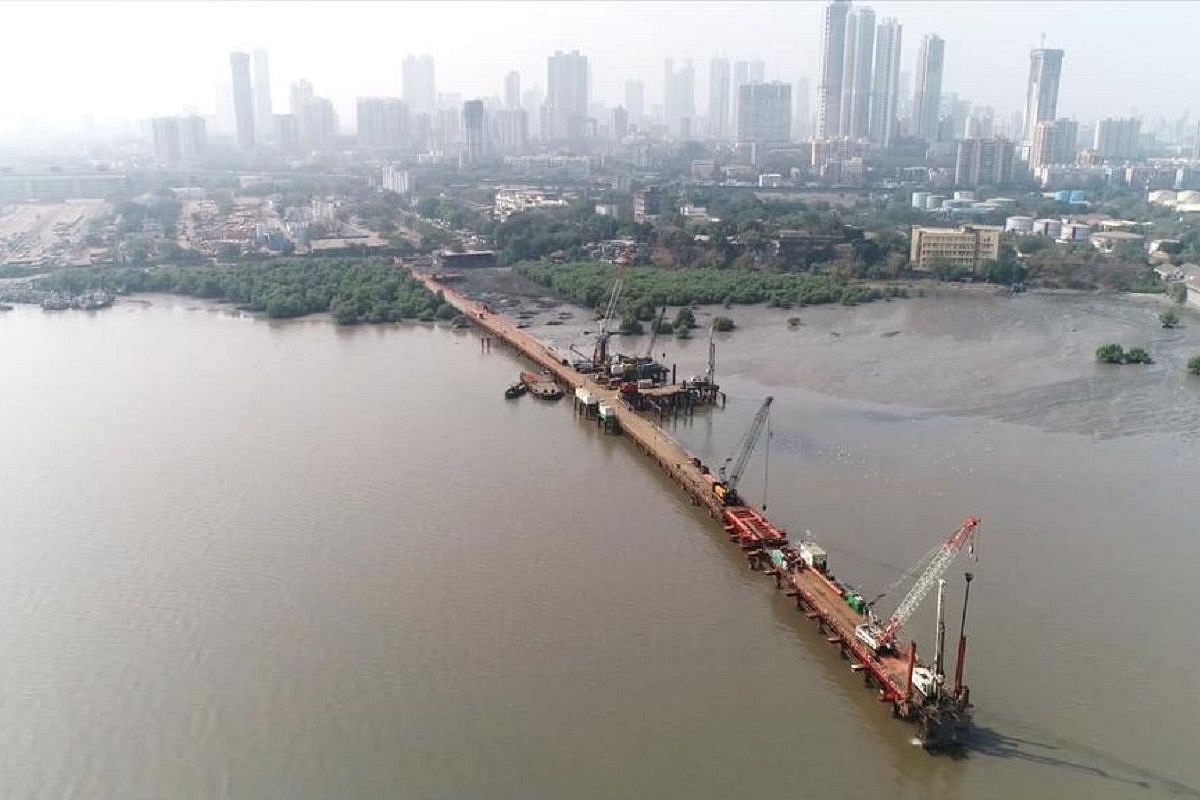Infrastructure
Why A Change Of Regime In Maharashtra Spells Great News For State's Infrastructure Development
- For Maharashtra to scale rapidly to a one trillion dollar economy, it must execute large-scale infrastructure projects all over the state — in terms of roads, railways, metro, ports and seaside living spaces, tourism infrastructure, airports and low-cost housing.
- Many such projects were stalled in the MVA regime, but Devendra Fadnavis' return could spell great news for the state's infrastructure development.

Construction of the Mumbai Trans Harbour Link (Ashwini BhideTwitter)
Maharashtra Chief Minister Uddhav Thackeray threw in the towel by announcing his resignation minutes after the Supreme Court refused to grant a stay on order by Governor Bhagat Singh Koshyari calling for a special session of the state assembly for Uddhav Thackeray-led Shiv Sena-Congress-NCP government to take a floor test.
The collapse of the Thackeray-led coalition government is set to pave the way for the return of a new government comprising of BJP and a rebel faction of Shiv Sena led by Eknath Shinde. While the exact contours of the new ruling regime are yet to emerge, BJP leader Devendra Fadnavis will likely be at the helm as the new chief minister.
While the Maharashtra political developments may have deeply polarised the public opinion along ideological lines, there is near unanimity among one section that the return of Fadnavis to the corridors of power is excellent news. This is the crowd of infrastructure enthusiasts in India.
During his tenure as CM between 2014 and 2019, Fadnavis played an instrumental role in reviving several infrastructure projects that had been languishing for years. Many transformative urban projects that have the potential to change the landscape of Mumbai were also launched.
Fadnavis set up a 'war room' to push key infrastructure projects in the state and ensure their completion within a set time frame. Fadnavis reviewed and fast-tracked nearly 20 infrastructure projects through his 'war room' model.
When first set up in 2015, the Fadnavis war room identified and took up 10 big infra projects, including the coastal road, Navi Mumbai airport, the second and third Mumbai Metro lines, the Mumbai Trans-harbour line and the Nagpur Metro, among others. Each one of these projects progressed rapidly during his tenure.
Take, for instance, the Mumbai Trans Harbour Link (MTHL) project. 53 years after conception, four attempts at tendering over twelve years, and 15 Chief Ministers since the Wilbur Smith report originally mooted the idea, it was Fadnavis who finally managed to get all boxes ticked to launch the project. After a detailed bidding process, the chosen contractors started work on the Rs 18,000 crore MTHL project in 2018.
The Fadnavis war room revived the MTHL project in 2015. Two crucial state and central clearances were obtained between November 2015 and January 2016. In February 2016, funding from Japan International Cooperation Agency (JICA) was secured subject to some design changes and construction standards to be followed. The central government readily stood counter-guarantee for the JICA loan. JICA agreed to fund eighty per cent of the cost at a concessional rate of interest, and the remaining twenty per cent came from Mumbai Metropolitan Region Development Authority (MMRDA) and the state government. The JICA agreement with MMRDA for the funding was signed in May 2016.
MTHL project involves the construction 21.8-km-long elevated road, of which 16.11 km is a sea-link that will connect Sewri in South Mumbai to Chile in Navi Mumbai. Around 80 per cent of the work on the ₹18,000 crore has been completed, and MMRDA plans to complete the rest before December 2023 and throw open the MTHL for public use.
Take the Mumbai Coastal Road project. Long put in cold storage, the Fadnavis-led government put it on a fast track. The ambitious road project, once completed, will add an 8.5 km long and 20-metre wide sea promenade to the city between Priyadarshini Park at Napean Sea Road, and the Worli side of the Bandra Worli Sea Link. In March 2022, the Brihanmumbai Municipal Corporation (BMC) stated that that the project would be completed by the predicted deadline of November 2023.
While the Maha Vikas Aghadi (MVA) government did not actively attempt to derail these two iconic infrastructure projects of Mumbai, several other projects initiated by the Fadnavis government have faced severe delays. Two projects that were particularly targeted by the MVA regime were the Mumbai Metro Line 3 and Mumbai-Ahmedabad Bullet Train.
Another stellar infrastructure project that Fadnavis government is widely credited with is the 701 km under-construction Mumbai–Nagpur Expressway (officially known as Hindu Hrudaysamrat Balasaheb Thackeray Maharashtra Samruddhi Mahamarg). Among India's longest Greenfield road projects, the expressway will connect the two capitals of the state Mumbai and Nagpur.
For Maharashtra to rapidly scale to a one trillion dollar economy, it must commission large-scale infrastructure projects all over the state — in terms of roads, railways, metro, ports and seaside living spaces, tourism infrastructure, airports and low-cost housing.
Support Swarajya's 50 Ground Reports Project & Sponsor A Story
Every general election Swarajya does a 50 ground reports project.
Aimed only at serious readers and those who appreciate the nuances of political undercurrents, the project provides a sense of India's electoral landscape. As you know, these reports are produced after considerable investment of travel, time and effort on the ground.
This time too we've kicked off the project in style and have covered over 30 constituencies already. If you're someone who appreciates such work and have enjoyed our coverage please consider sponsoring a ground report for just Rs 2999 to Rs 19,999 - it goes a long way in helping us produce more quality reportage.
You can also back this project by becoming a subscriber for as little as Rs 999 - so do click on this links and choose a plan that suits you and back us.
Click below to contribute.
Latest